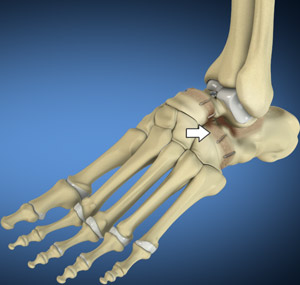Triple Arthrodesis
The foot is made up of 26 bones and 33 joints. The hind foot (back of foot) is made of the calcaneus (heel bone) and talus (ankle bone) which are connected by the subtalar joint. The other two joints at the back of the foot include talonavicular (connecting the talus and navicular bone) and calcaneocuboid (connecting the calcaneus and cuboid bone) joints. The three joints namely, subtalar, talonavicular, and calcaneocuboid allow side to side movement of the foot. These joints may become damaged due to arthritis or injury which makes the joint stiff and painful.
Triple fusion, also known as triple arthrodesis is a surgical procedure performed to fuse the three joints together and relieve pain caused by the underlying conditions.
Indications
Triple fusion surgery is indicated if conservative treatments such as medications and injections have failed to provide pain relief caused due to arthritis, injury or if the joint has worn out. The procedure is also indicated to treat severe foot deformity such as flat foot, cavus (high arch) foot or club foot (inward twisting of the foot).
Procedure
Triple fusion is performed under the effect of general or spinal anesthesia. During the procedure, the surgeon makes incisions, usually 4-5 cm in length on the outer and inner side of your foot to gain access to the joints. The triple joints are opened; joint surfaces are removed and reshaped if required. The joints are then placed together in their correct position and fixed with metal screws, plates and pins. Your surgeon may fix the subtalar joint with a screw in the back of the heel. After correction of the deformity, gaps between the joints may be packed with bone grafts taken from the leftover bone pieces or from the tibia or pelvis. The incisions are then sewed back together and dressed with a bandage.
Post-operative care
Following the surgery, you will be administered medications for pain relief. Keep the operated foot elevated to help reduce post-operative swelling. The leg will be plastered from the knee to toes until the joints have fused and you may have to use crutches to avoid putting weight on the operated foot. The plaster may be replaced during the follow-up visits to aid healing. Follow-up X-rays will be ordered after 3 months to check for joint fusion. Avoid excessive manual work, driving or vigorous exercises for a few weeks after the procedure.
Risks and complications
As with any procedure, triple fusion involves certain risks and complications. They include:
- Infection
- Nerve damage
- Stiffness
- Recurrent surgery for non-fused joints
- Malposition of the fused bones
- Loosening of the screws or pins
- Rarely, deep vein thrombosis or pulmonary embolism





